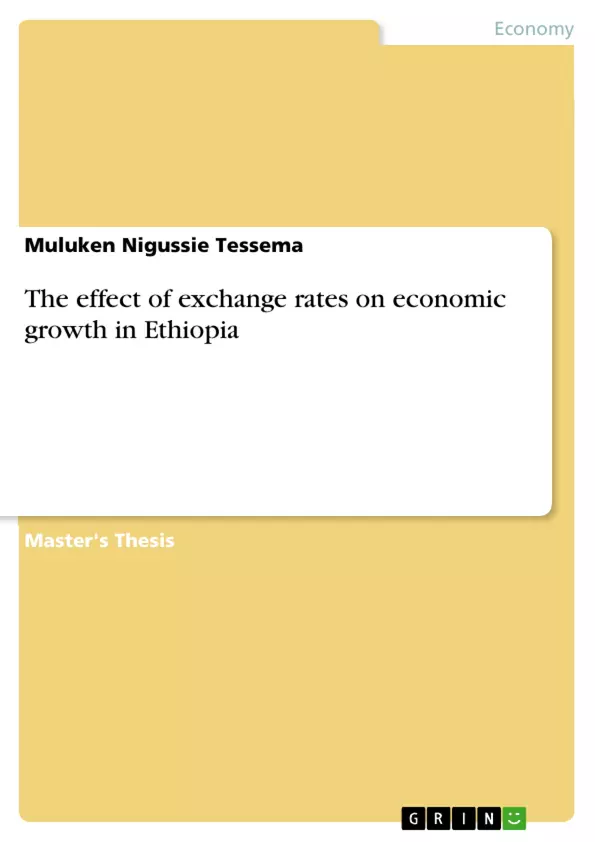
The effect of exchange rates on economic growth in Ethiopia
Masterarbeit, 2016
81 Seiten, Note: 3.68
Leseprobe
Inhaltsverzeichnis (Table of Contents)
- CHAPTER ONE: INTRODUCTION
- 1.1. Background of the Study
- 1.2. Statement of the Problem
- 1.3 Objective of the Study
- 1.4 Basic Research Questions
- 1.5 Hypothesis
- 1.6 Significance of the Study
- 1.7 Scope and Limitation of the Study
- 1.8 Organization of the study
- CHAPTER TWO: LITERATURE REVIEW
- 2.1 Brief discussion of exchange rate in Ethiopia
- 2.1.1 Definition
- 2.1.2 Exchange rate policy in Ethiopia
- 2.1.3 Exchange rates and economic growth in Ethiopia
- 2.1.4 Real and nominal effective exchange rates
- 2.2 Theoretical literature review
- 2.2.1 The traditional views of Exchange rate
- 2.2.2 The structuralist views of Exchange rate
- 2.2.3 The Balassa-Samuelson Hypothesis
- 2.2.4 The export-led growth hypothesis
- 2.3 Empirical literature review
- 2.1 Brief discussion of exchange rate in Ethiopia
- CHAPTER THREE: DATA AND METHODOLOGY
- 3.1 Introduction
- 3.2 Research Design
- 3.3 Data type and sources
- 3.4 Method of data analysis
- 3.5 Model specification
- 3.6 Unit root tests
- 3.7 Johansen cointagration test and VECM
- 3.8 Impulse response and variance decomposition analysis
- 3.9 Diagnostic checks
- CHAPTER FOUR: EMPIRICAL ANALYSIS AND DISCUSSION
- 4.1 Introduction
- 4.2 Descriptive data analysis
- 4.2.1 Real effective exchange rate and economic growth
- 4.3 Tests of the time series data
- 4.3.1 Stationarity tests
- 4.4 Test for cointegration
- 4.5 Determination of optimal lag length
- 4.6 Estimation results and interpretation
- 4.6.1 Vector Error Correction Model
- 4.7 Diagnostic tests on the residuals of VECM
- 4.8 Impulse response and variance decomposition analysis
Zielsetzung und Themenschwerpunkte (Objectives and Key Themes)
This thesis aims to investigate the effect of exchange rates on economic growth in Ethiopia. It seeks to analyze the relationship between exchange rate fluctuations and key macroeconomic indicators, contributing to a deeper understanding of the dynamics of economic growth within the Ethiopian context.
- The impact of exchange rate policies on economic growth in Ethiopia.
- The relationship between real and nominal effective exchange rates and economic growth.
- An empirical analysis of the effect of exchange rate volatility on economic growth.
- Evaluation of different theoretical perspectives on exchange rates and economic growth.
- Policy recommendations for managing exchange rates to promote sustainable economic growth in Ethiopia.
Zusammenfassung der Kapitel (Chapter Summaries)
CHAPTER ONE: INTRODUCTION: This chapter sets the stage for the thesis by providing background information on the Ethiopian economy and its relationship with exchange rates. It clearly states the research problem, outlining the gap in existing literature that the study aims to fill. The chapter also defines the study's objectives, research questions, and hypotheses, laying out the methodology and scope of the research. The significance of the study is highlighted, emphasizing its potential contribution to policy-making in Ethiopia. Finally, it details the structure and organization of the thesis.
CHAPTER TWO: LITERATURE REVIEW: This chapter undertakes a thorough review of existing literature relevant to the study's focus. It begins with a discussion of exchange rates in Ethiopia, covering their definition, policy implications, and historical context within the Ethiopian economy. The chapter proceeds to examine various theoretical perspectives on exchange rates and their influence on economic growth, including traditional, structuralist viewpoints, and prominent hypotheses like the Balassa-Samuelson and export-led growth hypotheses. A critical review of empirical studies focusing on the relationship between exchange rates and economic growth, particularly within developing economies, is also included, providing a framework for the current research.
CHAPTER THREE: DATA AND METHODOLOGY: This chapter details the research design, data sources, and analytical methods employed in the study. It specifies the types of data used (likely macroeconomic time-series data) and their sources within Ethiopian governmental institutions (Ministry of Finance and Economic Development, National Bank of Ethiopia, Central Statistics Agency). The chapter describes the econometric techniques utilized to analyze the data, including unit root tests for stationarity, cointegration tests (like the Johansen test) to determine long-run relationships, and vector error correction models (VECM) for dynamic analysis. The chapter also includes discussions of impulse response functions and variance decomposition techniques used to assess the impact of exchange rate shocks on the economy. Finally, it outlines the diagnostic checks performed to ensure the validity and reliability of the econometric results.
CHAPTER FOUR: EMPIRICAL ANALYSIS AND DISCUSSION: This chapter presents the empirical findings of the study. It begins with a descriptive analysis of the data, visualizing trends and patterns in the variables under investigation. The chapter then presents the results of the econometric analyses, including the outcomes of the stationarity, cointegration, and VECM estimations. The interpretation of the results is crucial here, explaining the statistical significance of the findings and their implications for the relationship between exchange rates and economic growth in Ethiopia. Detailed attention is paid to impulse response functions and variance decomposition analysis, interpreting their implications for economic policy. Finally, the chapter may include a discussion of any limitations or challenges encountered during the empirical analysis.
Schlüsselwörter (Keywords)
Exchange rates, economic growth, Ethiopia, macroeconomic indicators, exchange rate policy, real effective exchange rate, nominal effective exchange rate, econometric analysis, time series data, vector error correction model (VECM), cointegration, impulse response function, variance decomposition, developing economies.
Frequently Asked Questions: Analysis of Exchange Rates and Economic Growth in Ethiopia
What is the main topic of this research?
This research investigates the impact of exchange rates on economic growth in Ethiopia. It examines the relationship between exchange rate fluctuations and key macroeconomic indicators to understand the dynamics of economic growth within the Ethiopian context.
What are the key objectives of the study?
The study aims to analyze the impact of exchange rate policies on economic growth, explore the relationship between real and nominal effective exchange rates and growth, empirically assess the effect of exchange rate volatility, evaluate different theoretical perspectives on exchange rates and growth, and provide policy recommendations for managing exchange rates to promote sustainable economic growth in Ethiopia.
What are the key themes explored in the research?
Key themes include the impact of exchange rate policies, the relationship between real and nominal effective exchange rates and economic growth, the effect of exchange rate volatility, and an evaluation of various theoretical perspectives (traditional, structuralist, Balassa-Samuelson, export-led growth hypotheses).
How is the research structured?
The research is structured into four chapters: Chapter 1 (Introduction) provides background, problem statement, objectives, and methodology. Chapter 2 (Literature Review) examines existing literature on exchange rates and economic growth, both theoretically and empirically, focusing on the Ethiopian context. Chapter 3 (Data and Methodology) details the research design, data sources, and econometric techniques used (unit root tests, cointegration tests, VECM, impulse response functions, variance decomposition). Chapter 4 (Empirical Analysis and Discussion) presents and interprets the empirical findings, including descriptive analysis, econometric results, and policy implications.
What data and methodology are employed?
The study utilizes macroeconomic time-series data from Ethiopian governmental institutions (Ministry of Finance and Economic Development, National Bank of Ethiopia, Central Statistics Agency). Econometric techniques include unit root tests, cointegration tests (Johansen test), vector error correction models (VECM), impulse response functions, and variance decomposition analysis. Diagnostic checks are performed to ensure the reliability of results.
What are the key findings of the empirical analysis?
The empirical analysis chapter presents the results of descriptive data analysis, stationarity tests, cointegration tests, VECM estimations, impulse response functions, and variance decomposition. The interpretation of these results and their implications for the relationship between exchange rates and economic growth in Ethiopia are thoroughly discussed. This section also covers diagnostic tests on the residuals of the VECM.
What are the main conclusions and policy implications?
While specific conclusions are not detailed in this preview, the study aims to provide policy recommendations for managing exchange rates to promote sustainable economic growth in Ethiopia based on the empirical findings and interpretation of the relationship between exchange rates and macroeconomic indicators.
What are the keywords associated with this research?
Keywords include: Exchange rates, economic growth, Ethiopia, macroeconomic indicators, exchange rate policy, real effective exchange rate, nominal effective exchange rate, econometric analysis, time series data, vector error correction model (VECM), cointegration, impulse response function, variance decomposition, developing economies.
Details
- Titel
- The effect of exchange rates on economic growth in Ethiopia
- Hochschule
- Saint Mary's University
- Note
- 3.68
- Autor
- Muluken Nigussie Tessema (Autor:in)
- Erscheinungsjahr
- 2016
- Seiten
- 81
- Katalognummer
- V537795
- ISBN (eBook)
- 9783346145147
- ISBN (Buch)
- 9783346145154
- Sprache
- Englisch
- Schlagworte
- ethiopia
- Produktsicherheit
- GRIN Publishing GmbH
- Preis (Ebook)
- US$ 38,99
- Preis (Book)
- US$ 49,99
- Arbeit zitieren
- Muluken Nigussie Tessema (Autor:in), 2016, The effect of exchange rates on economic growth in Ethiopia, München, Page::Imprint:: GRINVerlagOHG, https://www.diplomarbeiten24.de/document/537795
- Autor werden
- Ihre Optionen
- Vertriebskanäle
- Premium Services
- Autorenprofil
- Textarten und Formate
- Services für Verlage, Hochschulen, Unternehmen

- © GRIN Publishing GmbH.
- Alle Inhalte urheberrechtlich geschützt. Kopieren und verbreiten untersagt.
- info@grin.com
- AGB
- Open Publishing
Der GRIN Verlag hat sich seit 1998 auf die Veröffentlichung akademischer eBooks und Bücher spezialisiert. Der GRIN Verlag steht damit als erstes Unternehmen für User Generated Quality Content. Die Verlagsseiten GRIN.com, Hausarbeiten.de und Diplomarbeiten24 bieten für Hochschullehrer, Absolventen und Studenten die ideale Plattform, wissenschaftliche Texte wie Hausarbeiten, Referate, Bachelorarbeiten, Masterarbeiten, Diplomarbeiten, Dissertationen und wissenschaftliche Aufsätze einem breiten Publikum zu präsentieren.
Kostenfreie Veröffentlichung: Hausarbeit, Bachelorarbeit, Diplomarbeit, Dissertation, Masterarbeit, Interpretation oder Referat jetzt veröffentlichen!
- GRIN Verlag GmbH
-
- Nymphenburger Str. 86
- 80636
- Munich, Deutschland
- +49 89-550559-0
- +49 89-550559-10
- info@grin.com
-









